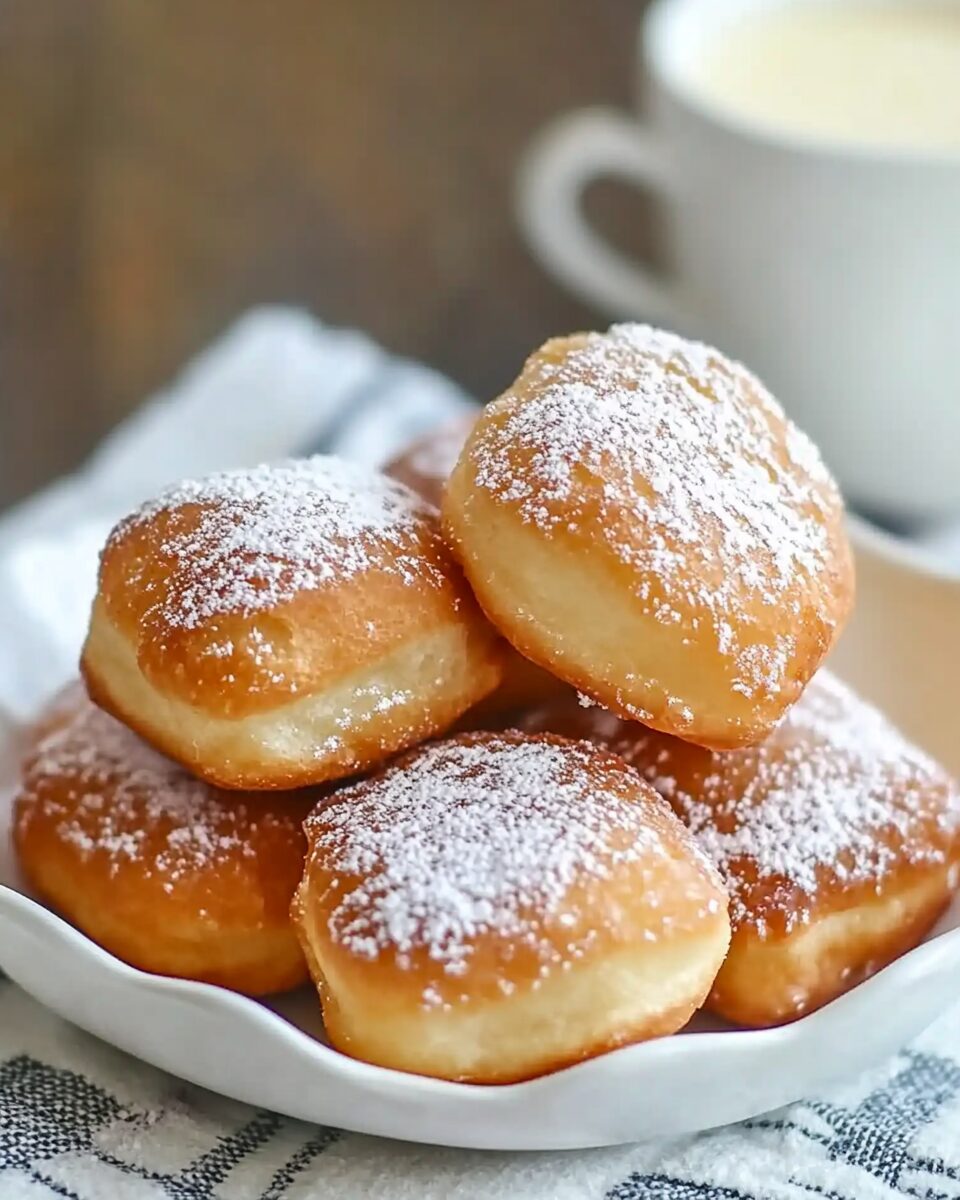Vanilla French Beignets are a classic French pastry known for their pillowy texture, golden crispiness, and a dusting of powdered sugar that makes each bite sweet and irresistible. Often enjoyed as a breakfast or brunch treat in New Orleans’ French Quarter, these beignets have a subtle hint of vanilla that adds depth and warmth to their flavor. Whether served with a hot café au lait or as a simple dessert, beignets are the ultimate comfort pastry that’s perfect for sharing. This recipe brings authentic café-style beignets right into your kitchen, using straightforward ingredients and traditional frying methods to achieve that perfect light and airy bite.
Full Recipe:
Ingredients
¾ cup warm water (around 110°F)
2 ¼ tsp active dry yeast (1 packet)
¼ cup granulated sugar
2 large eggs
½ cup whole milk
3 tbsp unsalted butter, melted
1 tsp vanilla extract
4 cups all-purpose flour
Pinch of salt
Vegetable oil (for frying)
Powdered sugar (for dusting)
Directions
In a small bowl, dissolve yeast in warm water with a pinch of sugar and let sit for 5 minutes until frothy.
In a large bowl, whisk together sugar, eggs, milk, melted butter, and vanilla. Gradually add in flour and salt, stirring until dough forms. Knead until smooth.
Let the dough rise in a warm place, covered, for 1–2 hours until doubled in size.
Roll out the dough on a floured surface to about ½-inch thickness. Cut into squares or circles.
Heat oil to 350°F in a deep pot or fryer. Fry beignets in batches, about 2–3 minutes per side, until puffed and golden brown.
Remove and drain on paper towels. While still warm, generously dust with powdered sugar and serve immediately.
Nutrients (Per Beignet – Approximate)
Calories: 180 kcal
Carbohydrates: 22g
Protein: 3g
Fat: 9g
Saturated Fat: 3g
Cholesterol: 35mg
Sugar: 8g
Sodium: 80mg
Fiber: <1g
What Makes These Beignets Special
The defining trait of a great beignet lies in its texture: it should be feather-light with a slightly chewy center and delicately crispy edges. Achieving this involves a well-developed dough, plenty of rising time, and precise frying temperature. In this recipe, the addition of vanilla brings a delicate floral sweetness that enhances the otherwise neutral dough without overpowering it.
Unlike heavy donuts or overly sugary breakfast treats, beignets walk the line between indulgent and elegant. They’re sweet but not cloying, rich yet airy, and their simple appearance belies their complex flavor. When you take a bite, you’ll taste a hint of buttery richness, a touch of vanilla, and the irresistible warmth of fresh pastry.
A Celebratory Pastry with Rich History
Beignets are deeply rooted in both French and Creole cuisine. Their origins date back centuries, with French colonists bringing the recipe to Louisiana. Over time, it became a staple in New Orleans’ culinary scene, particularly associated with Mardi Gras and morning gatherings. While variations exist across cultures—think zeppole in Italy or Berliner in Germany—the French-style beignet stands out for its yeasted dough and pillow-soft consistency.
Today, they are often found at New Orleans cafés, served in paper-lined baskets with cups of café au lait. However, their popularity has spread far beyond Louisiana, thanks to their unbeatable flavor and texture. Making them at home connects you to this culinary heritage, allowing you to enjoy a beloved tradition any day of the week.
Why Vanilla is the Star Here
Classic beignet dough is mildly flavored to let the texture and sugar shine, but adding vanilla gives these treats a gourmet edge. It brings warmth and depth without altering the classic profile. The result is a more fragrant and well-rounded beignet that pairs wonderfully with sweet toppings or fillings, yet stands strong on its own.
Vanilla also adds a sensory experience—the aroma as the beignets fry, the subtle flavor that lingers on the palate, and the nostalgic comfort it invokes. This makes them perfect for both casual breakfasts and elegant brunch spreads.
Tips for the Best Beignets at Home
While the process is straightforward, there are a few keys to success. First, let your dough rise fully; this ensures airiness and structure. Second, use a thermometer to maintain your oil at 350°F—too hot and the outside will burn before the inside cooks; too cool and your beignets will be greasy.
Cutting the dough into uniform sizes ensures even frying. Use a pizza cutter or sharp knife, and try for squares roughly 2 to 3 inches across. Be sure not to overcrowd the oil, as this drops the temperature and leads to uneven cooking.
Once the beignets are golden and puffed, drain them briefly and dust with powdered sugar while still warm. This helps the sugar stick and creates that iconic snowy coating everyone loves.
How to Serve Vanilla French Beignets
There’s no wrong time to enjoy a beignet. Serve them hot, fresh from the fryer, with coffee for a true New Orleans-style breakfast. They also shine at brunches, tea parties, and holiday mornings. Try serving with:
-
Warm chocolate dipping sauce
-
A side of raspberry or strawberry jam
-
A drizzle of caramel or vanilla glaze
-
Fresh fruit and whipped cream for a plated dessert
For a more decadent version, consider stuffing them with pastry cream, Nutella, or a fruit compote using a piping bag and small tip.
Perfect for Any Occasion
These Vanilla French Beignets are versatile enough to match any mood or event. Hosting a baby shower? Stack them on a platter with berries. Planning a lazy weekend morning? Dust generously and pair with espresso. Celebrating Mardi Gras? Serve alongside king cake and zydeco tunes. Their understated elegance means they blend into formal events just as easily as they do on a casual breakfast table.
They also make wonderful homemade gifts. Pile cooled beignets into a tin or parchment-lined box, tie with ribbon, and include a small jar of flavored sugar for a sweet personal touch.
Storage and Reheating Tips
While nothing compares to a fresh beignet, you can enjoy leftovers with a bit of care. Store cooled beignets in an airtight container at room temperature for up to 2 days. To reheat, place in a 300°F oven for 5–7 minutes. Avoid the microwave, which tends to make them rubbery.
If making ahead, consider preparing and refrigerating the dough overnight, then allowing it to come to room temperature and rise before frying the next day. This gives you fresh beignets in the morning with less prep.
Conclusion
Vanilla French Beignets are the ultimate treat that merges tradition, simplicity, and indulgence in one beautifully puffed bite. With their pillowy interior, crisp edges, and irresistible powdered sugar coating, these pastries are more than just food—they’re an experience. The vanilla infusion elevates them to a new level of flavor sophistication, making them perfect for everything from everyday comfort to special-occasion splendor.
Whether you’re bringing a taste of New Orleans into your home, delighting your weekend brunch guests, or just treating yourself to something sweet and satisfying, these beignets are sure to bring joy. Once you’ve made them, don’t be surprised if they become a beloved tradition in your own kitchen, too.

